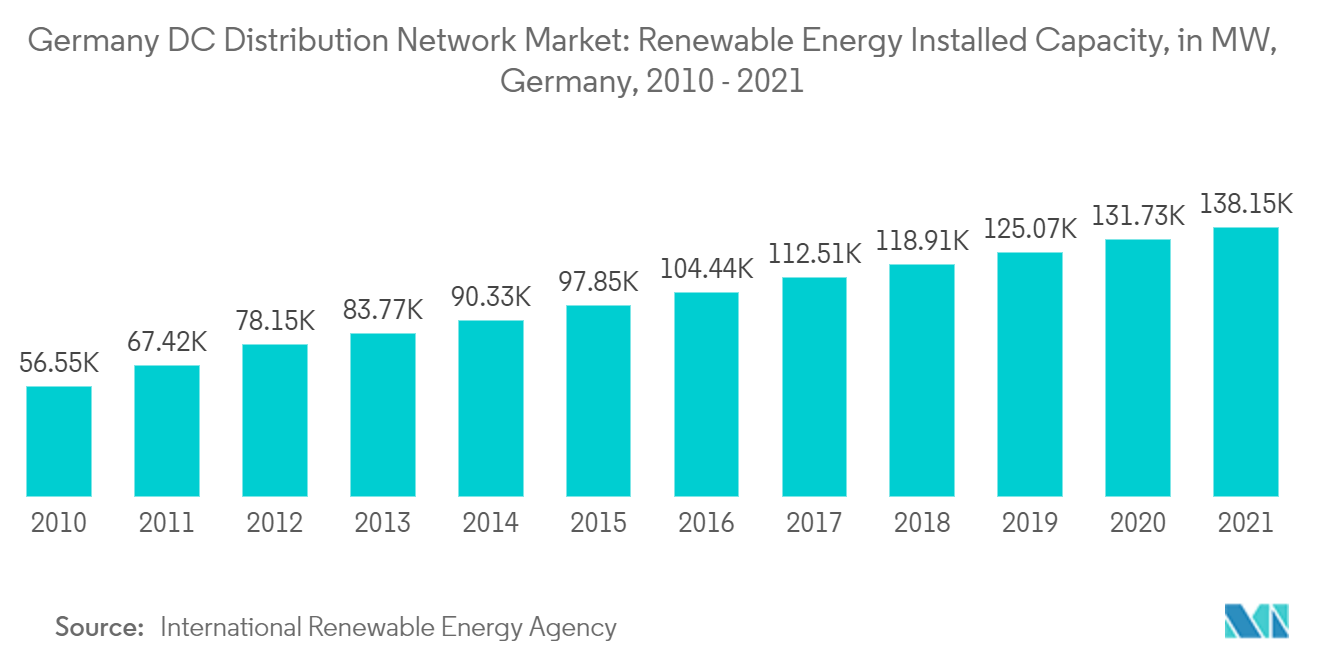Market Trends of Germany DC Distribution Network Industry
This section covers the major market trends shaping the Germany DC Distribution Networks Market according to our research experts:
Growth in the Renewable Energy Sector to Drive the Market
- The renewable energy generation capacity is growing at a higher rate. Most of the renewable power generation facilities are located at a distance from the load centres. High-voltage DC (HVDC) is essential for remote projects, as cable lengths of approximately 80 km or more are fundamentally compatible with the HVDC transmission technology.
- In 2021, renewable energy capacity in Germany amounted to 138.2 gigawatts. This was an increase of nearly five percent from the previous year, and the peak from the period in consideration.
- Since the HVDC lines are better suited for long-distance power transmission, power transmission companies are increasingly choosing HVDC over HVAC transmission lines, in order to integrate the renewable power capacity.
- As the conversion of DC voltage to AC voltage, for distribution, may only reduce the efficiency of the system, DC distribution is considered to be the most suitable form of the distribution system, due to its higher efficiency.
- In May 2021, RWE and BASF planned to invest USD 4.9 billion in offshore wind power projects. As part of the project, RWE intends to build a 2 GW offshore wind park by 2030. The project aims to supply energy to BASF's Ludwigshafen chemical complex.
- In November 2021, RWE announced plans to invest USD 57 billion by 2030. The investment aims to double its green energy to 50 gigawatts (GW).
- Therefore, growth in the renewable energy sector is likely to drive the growth of Germany DC distribution network market during the forecast period.

EV Fast Charging Systems to Witness Significant Growth
- The electric vehicle (EV) charging system segment is booming due to many factors such as increasing adoption of electric vehicles, supportive government policies across the European countries etc. Moreover, oil is considered as a limited resource, and an alternate source of transportation fuel like electricity is not only a smart investment but also an inevitable one.
- German electric car sales accounted about 681,400 plug-in hybrid electric vehicles in 2021. In the same year, battery-electric passenger vehicles represented the largest segment of the market for vehicles with an electric drivetrain.
- The number of plug-in electric vehicles (PEVs), including battery electric vehicles (BEVs) and plug-in hybrid electric vehicles (PHEVs), have been rising, which, in turn, expected to drive the DC distribution network market, during the forecast period.
- The development in power electronics technology, such as microgrids, is mostly connected to distribution networks. In the power industry, the flexible DC distribution network has got attention for its lower integration and construction costs, reduction in energy loses, and higher reliability.
- However, in the current market scenario, charging stations are yet to become a viable economic investment, due to their lower utilization and relatively high upfront cost, particularly for DC.
- In November 2022, PKN ORLEN announced plans to develop a network of electric vehicle (EV) charging stations in Europe, including Germany, the Czech Republic, and Poland. In Germany, about 434 EV charging stations are expected to be launched by the end of 2026. While the ORLEN Group already has 470 points in Poland, with 63 locations in Germany and the Czech Republic.
- Therefore, based on the aforementioned factors, electric vehicles fast charging systems is likely to witness significant demand for Germany DC distribution network market over the forecast period.


